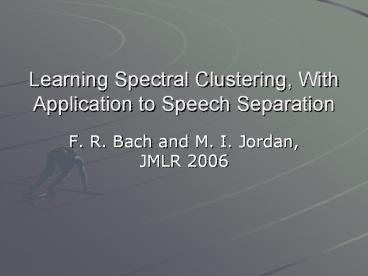Learning%20Spectral%20Clustering,%20With%20Application%20to%20Speech%20Separation - PowerPoint PPT Presentation
Title:
Learning%20Spectral%20Clustering,%20With%20Application%20to%20Speech%20Separation
Description:
W is not necessarily positive semidefinite; ... R-way Normalized Cuts ... into R disjoint clusters by minimizing the normalized cut, cost function, C(A, W) ... – PowerPoint PPT presentation
Number of Views:72
Avg rating:3.0/5.0
Title: Learning%20Spectral%20Clustering,%20With%20Application%20to%20Speech%20Separation
1
Learning Spectral Clustering, With Application to
Speech Separation
- F. R. Bach and M. I. Jordan, JMLR 2006
2
Outline
- Introduction
- Normalized cuts -gt Cost functions for spectral
clustering - Learning similarity matrix
- Approximate scheme
- Examples
- Conclusions
3
Introduction 1/2
- Traditional spectral clustering techniques
- Assume a metric/similarity structure, then use
clustering algorithms. - Manual feature selection and weight are
time-consuming. - Proposed method
- A general framework for learning the similarity
matrix for spectral clustering from data. - Assume given data with known partitions and want
to build similarity matrices that will lead to
these partitions in spectral clustering. - Motivations
- Hand-labelled databases are available image,
speech. - Robust to irrelevant features.
4
Introduction 2/2
- Whats new?
- Two cost functions J1(W, E), J2(W, E), W
similarity matrix, E a partition. - MinE J1 ? New clustering algorithms
- MinW J1 ? learning the similarity matrix
- W is not necessarily positive semidefinite
- Design numerical approximation scheme for large
scale.
5
Spectral Clustering NCuts 1/4
- R-way Normalized Cuts
- Each data point is one node in a graph, the
weight on the edge connecting two nodes is the
similarity of those two. - A graph is partitioned into R disjoint clusters
by minimizing the normalized cut, cost function,
C(A, W), - V1,,P, index set of all data points
- AArr?1,,R, Union of ArV.
- is total
weight between A and B. -
, normalized term penalizes unbalanced
partition.
6
Spectral Clustering NCuts 2/4
- Another form of Ncuts
- E(e1,,eR), er is the indicator vector (P by 1)
for the r-th cluster. - Spectral Relaxation
- Removing the constraint (a), the relaxed
optimization problem is solved as follows, - The relaxed solutions generally are not piecewise
constant, so have to be projected back to subset
defined by (a).
7
Spectral Clustering NCuts 3/4
- Rounding
- Minimization of a metric between the relaxed
solution and the entire set of discrete allowed
solutions, - Relaxed solution
- Desired solution
- Try to compare the subspaces spanned by their
columns? compare the orthogonal projection
operator on those subspaces, i.e. Frobenius norm
between YeigYeigTUUT and
. - Cost function is given as
8
Spectral Clustering NCuts 4/4
- Spectral clustering algorithms
- Variational form of cost function,
- An weighted K-means algorithm can be used to
solve the minimization.
9
Learning the Similarity Matrix 1/2
- Objective
- Assume known partition E and a parametric form
for W, learn parameters that generalized to
unseen data sets. - Naïve approach
- Minimize the distance between true E and the
output of spectral clustering algorithm (function
of W). - Hard to optimize because of non continuous cost
function. - Cost functions as upper bounds of naïve cost
function - Minimize cost function J1(W, E), J2(W, E) is
equivalent to minimize an upper bound on the true
cost function.
10
Learning the Similarity Matrix 2/2
- Algorithms
- Given N data sets Dn, each Dn is composed of Pn
points - Each data set is segmented, known partition En
- The cost function is
- L-1 norm feature selection
- Use steepest descent method to minimize H(a)
w.r.t a.
11
Approximation Scheme
- Low-rank nonnegative decomposition
- Approximate each column of W by a linear
combination of a set of randomly chosen columns
(I) wj?i?IHijwi , j?J - H is chosen so that
is minimum. - Decomposition
- Randomly select a set of columns (I)
- Approximate W(I,J) as W(I,I)H.
- Approximate W(J,J) as W(J,I)HHTW(I,J).
- Complexity
- Storage requirement is O(MP), M is of selected
columns. - Overall complexity is O(M2P).
12
Toy Examples
13
Line Drawings
Training set 1 Favor connectedness
Training set 2 Favor direction continuity
Examples of testing segmentation trained with
Training set 2
Examples of testing segmentation trained with
Training set 1
14
Conclusions
- Two sets of algorithms are presented one for
spectral clustering and one for learning the
similarity matrix. - Minimization of a single cost function w.r.t. its
two arguments leads to these algorithms. - The approximation scheme is efficient.
- New approach is more robust to irrelevant
features than current methods.































